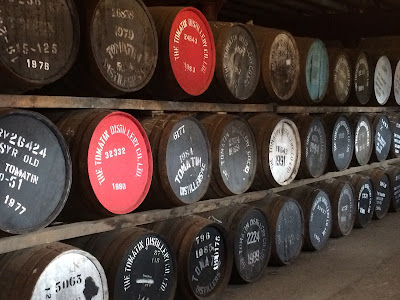Our first stop today was at a scotch distillery: Tomatin. Its one of the smaller ones. About 50 employees and produces about 170,000 bottles a year. We had an almost private tour with a well informed and entertaining guide. He walked us through the entire facility and explained in detail the scotch making process and talked about what made each type of scotch different. At Tomatin, they used peat smoke to dry the germinated barley grains which gives is a smokey taste, but they only slightly smoke it (compared to some of the others). We could smell both smoked and unsmoked dried barley grains.
These are the tanks where they add the yeast to the water and barley mixture (malt).This is standing inside an old mixer where they added water to the barley and drained out the sugared water to the tanks with the yeast. (The small hole in the floor is where they removed the remains of the grain after soaking it three times - sometimes it would plug up and they would stick a soccer ball in with some compressed air and clean it right out). Nearly all of the by-product from the manufacturing process is used for other things (feeding cattle, fertilizing fields, etc.)
The special part of each distillery that is different is the distilling tanks where the spirits are boiled off from the rest of the liquid mix. The process requires copper distilling tanks and each one at different distilleries are shaped uniquely.
After the distilling process, the spirits are put in the oak barrels. These are often 'seasoned' with other liquors, including Sherry and bourbon. The oak and the flavor from previous liquors provide unique flavor to the scotch. Tomatin did not sell any scotch that was younger than 5 years. In order for it to legally be scotch, it must have 40%+ alcohol content.
The barrels are painted with a different color each time they are reused. They don't use them more than 5 times, most common is 3 times before all the 'flavoring' is leached out of the oak. Its the oak that givens the drink its amber color.






No comments:
Post a Comment